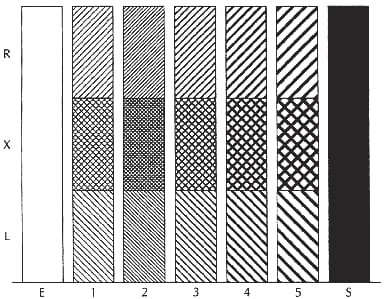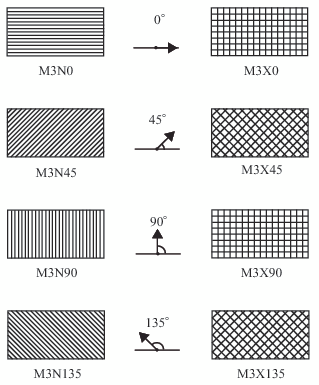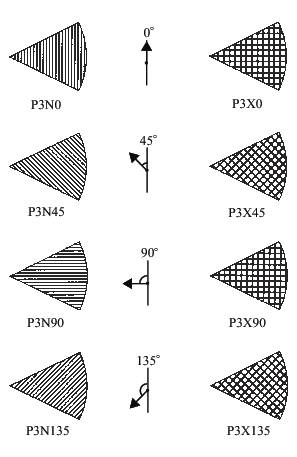PATTERN Statement
| Used by: | GAREABAR, GBARLINE, GCHART, GCONTOUR, GMAP, GPLOT, SYMBOL statement, Annotate facility |
| Type: | Global |
Syntax
<IMAGE= fileref | external-file”>
<IMAGESTYLE= TILE | FIT>
<REPEAT=number-of-times>
<VALUE=bar/block-pattern | map/plot-pattern | pie/star-pattern> ;
Optional Arguments
- COLOR=pattern-color | _style_
-
specifies the color of the fill. Pattern-color is any
SAS/GRAPH Using the COLOR= option with a null value cancels the color specified in a previous PATTERN statement of the same number without affecting the values of other options.The CFILL= option in the PIE and STAR statements overrides the COLOR= option. For details, see Controlling Slice Patterns and Colors.If no color is specified for a PATTERN statement, that is, if neither the COLOR= nor the CPATTERN= option is used, the PATTERN statement rotates the specified fill through each color in the color list before the next PATTERN statement is used.Alias: C=Restriction: Partially supported by Java and ActiveXNote:ActiveX assigns colors in a different order from Java, so the same data can appear differently with those two drivers.
- IMAGE= fileref | “external-file”
-
specifies an image file that is used to fill one or more bars of a bar chart, as generated by the HBAR and VBAR statements of the GCHART procedure, and, in some cases, as generated by the HBAR3D and VBAR3D statements of the GCHART procedure. The format of the external file specification varies across operating environments. See the companion reference for your specific operating environment.Restriction:Partially supported by Java and ActiveXNotes:When you specify an image file to fill a bar, the bar is not outlined. Also, the COLOR= and VALUE= options are ignored.
If an image is specified on a PATTERN statement that is used with another type of chart, then the PATTERN statement is ignored and default pattern rotation is affected. For example, if you submit a PIE statement when an image has been specified in a PATTERN statement, the default fill pattern is used for the pie slices, with each slice in the pie displaying the fill pattern in the same color.
For DEVICE=ACTIVEX and DEVICE=ACTXIMG, if you do not specify a pathname to the image, then the ActiveX control searches a predefined list of locations to try to find the image. If all else fails, the ActiveX control looks for the image on the Web. It is recommended that you specify the pathname to the image.
For DEVICE=ACTIVEX and DEVICE=ACTXIMG, the IMAGE= option works for the VBAR and HBAR statements as well as the VBAR3D and HBAR3D statements. For all other devices, the IMAGE= option works only for the VBAR and HBAR statements.
See:Displaying Images on Data Elements for related information
- IMAGESTYLE = TILE | FIT
-
specifies how the image specified in the IMAGE= option is to be applied to fill a bar in a bar chart. The TILE value, which is the default, repeats the image as needed to fill the bar. The FIT value stretches a single instance of the image to fill the bar.Restriction:Partially supported by Java and ActiveX
- REPEAT=number-of-times
-
specifies the number of times that a PATTERN definition is applied before the next PATTERN definition is used. By default, REPEAT=1.
-
If you omit both the COLOR= and CPATTERN= options, and use the REPEAT= option either alone (generates default solids) or with the VALUE= option in a PATTERN statement, the resulting pattern is rotated through each color in the color list, and then the entire group generated by this cycle is repeated the number of times specified in the REPEAT= option. Thus, the total number of patterns produced depends on the number of colors in the current color list.
- VALUE=bar/block-pattern
-
specifies patterns for:
-
the blocks in block maps produced by the BLOCK statement in the GMAP procedure. (The map area from which the block rises takes a map pattern as described in the option VALUE=map/plot-pattern .) See also About Block Maps and Patterns.
- style<density>
-
a shaded pattern. Style specifies the direction of the lines:Density specifies the density of the pattern's shading. Specify a number from 1 to 5. The number 1 produces the lightest shading and 5 produces the heaviest shading.Bar and Block Patterns shows all of the patterns available for bars and blocks.Bar and Block Patterns

-
SOLID
-
X1–X5
-
L1–L5
-
R1–R5
Each fill is used once with every color in the color list unless a pattern color is specified. The entire sequence is repeated as many times as required to provide the necessary number of patterns.Alias: V=Restriction:Partially supported by Java and ActiveX -
- VALUE=map/plot-pattern
-
Values for map/plot-pattern are as follows:
- MEMPTY
-
specifies an empty pattern. EMPTY or E are also valid aliases, except when used with the map areas in block maps created by the GMAP procedure.Alias:ME
- MSOLID
-
specifies a solid pattern. SOLID or S are also valid aliases, except when used with the map areas in block maps created by the GMAP procedure.Alias:MS
- Mdensity<style<angle>>
-
specifies a shaded pattern.Density specifies the density of the pattern's shading. Specify a number from 1 to 5. The number 1 produces the lightest shading and 5 produces the heaviest shading.Angle specifies the angle of the pattern lines. Specify a number from 0 to 360. The number specifies the degrees at which the parallel lines are drawn, measured from the horizontal. By default, angle is 0 (lines are horizontal).Note:Mdensity<style<angle>> is not supported by the Java or ActiveX device drivers.
-
MSOLID
-
M2N0
-
M2N90
-
M2X45
-
M4N0
-
M4N90
-
M4X90
Each fill is used once with every color in the color list unless a pattern color is specified. The entire sequence is repeated as many times as required to provide the necessary number of patterns.Alias:V=Restriction:Partially supported by Java and ActiveX
- VALUE=pie/star-pattern
-
specifies patterns for pie and star charts produced by the PIE and STAR statements in the GCHART procedure. Values for pie/star-pattern are as follows:
- Pdensity<style<angle>>
-
specifies a shaded pattern.Density specifies the density of the pattern's shading. Specify a number from 1 to 5. The number 1 produces the lightest shading and 5 produces the heaviest shading.Angle specifies the angle of the pattern lines. Specify a number from 0 to 360. The number specifies the angle of the lines, measured in degrees from perpendicular to the radius of the slice. By default, angle is 0.Note:Pdensity<style<angle>> is not supported by the Java or ActiveX device drivers.
-
PSOLID
-
P2N0
-
P2N90
-
P2X45
-
P4N0
-
P4N90
-
P4X90
Each fill is used once with every color in the color list unless a pattern color is specified. The entire sequence is repeated as many times as required to provide the necessary number of patterns.Alias:V=Restriction:Partially supported by Java and ActiveXNote:If you use hatch patterns and request a legend instead of slice labels, the patterns in the slices are oriented to be visually equivalent to the legend.
Details
Description: PATTERN Statement
Using the PATTERN Statement
How PATTERN Definitions Are Generated
Altering or Canceling PATTERN Statements
pattern4 value=x3 color=red repeat=2;
pattern4 color=blue;
pattern4;
goptions reset=pattern;
About Default Patterns
How SAS/GRAPH Generates and Assigns PATTERN Definitions
How Default Patterns and Outlines Are Generated
-
selects the first default fill for the appropriate pattern, which is always solid, and rotates it once through the list of colors available in the current style, generating one solid pattern for each color. If you use the default style colors and the first color in the list is either black or white, the procedure does not create a pattern in that color. If you specify a color list with the COLORS= graphics option, then the procedure uses all the colors in the list to generate the patterns.Note: The one exception to the default solid pattern is the map area pattern in a block map produced by the GMAP procedure, which uses a hatch fill by default. By default the map areas and their outlines use the first color in the color list, regardless of whether the list is the default device list or one specified with COLORS= in the GOPTIONS statement.
Things That Affect Default Patterns
-
If you specify a color list with the COLORS= option in a GOPTIONS statement and the list contains more than one color,
SAS/GRAPH
Working with PATTERN Statements
What You Can Specify with PATTERN Statements
Explicitly Specifying Patterns
Generating Multiple Pattern Definitions
pattern1 value=r3;
Selecting an Appropriate Pattern
The Effect of the CPATTERN= Graphics Option
Understanding Pattern Sequences
About Pattern Sequences
Generating Pattern Sequences
goptions colors=(blue red green) ctext=black; pattern1 color=red value=x3; pattern2 value=r3; pattern3 color=blue value=l3;
PATTERN1 generates
the first PATTERN definition. PATTERN2 omits
the COLOR= option, so the specified fill is rotated through all three
colors in the color list before the PATTERN3 statement is used. This
table shows the color and fill of the PATTERN definitions that would
be generated if nine patterns were required:
Repeating Pattern Sequences
goptions colors=(red blue green); pattern1 color=gold repeat=2; pattern2 value=x1 repeat=2;

